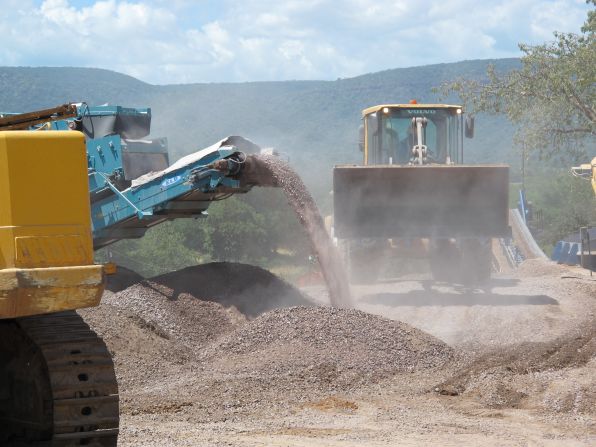By Fanuel Chinowaita
CHIADZWA, ZIMBABWE , 15 May 2025– What was once a beacon of Zimbabwe’s economic promise has become a symbol of environmental destruction and social decay. The diamond mining boom in Chiadzwa, which began in 2006, enriched Chinese nationals, politically connected elites, and private syndicates but left the local community impoverished, displaced, and environmentally devastated.
Nearly two decades later, residents of Chiadzwa are grappling with the aftermath of a mining frenzy that not only failed to uplift local livelihoods but also inflicted irreversible environmental damage and sparked climate-related concerns.
The Chiadzwa diamond fields, located in Marange under Mutare District, witnessed intense extraction by companies such as Anjin Investments and the state-run Zimbabwe Consolidated Diamond Company (ZCDC). While billions of dollars’ worth of diamonds were extracted and exported, local people were displaced many forcibly relocated to Odzi with no meaningful compensation or sustainable development plans.
Today, what remains is a wasteland. Chemical blasting during mining operations reportedly released toxic substances that spread across a 5-kilometre radius, affecting human health, vegetation, and wildlife. Community members and watchdog groups like the Marange Development Trust (MDT) say the micro-climate of the area has been significantly altered.
“The smell during blasting was unbearable. Our cattle died. Some trees stopped flowering. We are breathing toxins and living with the consequences,” said a local resident who requested anonymity.
Environmental degradation is visible throughout Chiadzwa: gaping open pits left unattended, unrehabilitated land, and silted rivers. The roads are in poor condition the tarred stretch ends at Gomorefu High School, and on the Masvingo side, the road narrows dangerously. It’s an ironic gateway into one of the world’s richest diamond deposits.
A joint site visit by MDT and the Zimbabwe Environmental Law Association (ZELA) in April 2025 confirmed the concerns. The tour uncovered widespread pollution, mismanaged waste, and unsafe living conditions for residents near mining zones.
“The environmental damage is massive. Chiadzwa is no longer safe physically or environmentally. This is a wound that may never heal,” said MDT Chairperson Malvern Mudiwa.
Beyond environmental harm, the social costs have escalated. Once a vibrant rural community, Marange now faces a drug and substance abuse crisis—fueled by years of poverty, trauma, and neglect.
According to MDT’s research, the peak of informal mining (2006 – 2013) introduced drugs such as marijuana, mutoriro (methamphetamine), and even cigarette lighter gas to local youths substances used to gain courage to enter high-security mining zones. The culture of addiction has only worsened.
“We interviewed over 20 youths in Betera and Muchena villages, and the story was the same hopelessness, addiction, school dropouts, and early pregnancies. This is the forgotten legacy of diamond mining,” said MDT member Patricia Chibato.
Amid growing unrest, ZCDC is reportedly planning to retrench around 700 workers, citing financial constraints. Internal sources say some employees have already been asked to resign voluntarily due to the company’s failure to meet salary obligations.
Cosmas Sunguro, Chairperson of the Zimbabwe Diamond and Allied Workers Union (ZIDAWU), expressed deep concern.
“This is a very unfortunate move. Why sacrifice the bees that make the honey? It’s not fair,” he said.
Sunguro clarified that Anjin Investments is not shutting down operations, dismissing circulating rumors.
“Anjin closing? Why? There’s nothing like that,” said the company’s Public Relations Manager, Special Matarirano.
However, Sunguro raised alarms over the continued exploitation of workers through short-term contracts.
“Workers are being laid off when contracts end, and after two weeks, new ones are hired. This is pure exploitation,” he added.
He emphasized that ZIDAWU’s mission is to protect both current and former employees by educating them on their rights.
“An empowered worker is not easily abused. We train and educate them.”
On the issue of health and safety, Sunguro stressed the need for compliance with national and international standards.
“Health and safety are governed by the Labour Act, the Constitution, and ILO conventions. We are pushing for companies to respect these standards and for workers to prioritize safety in all they do.”
Stakeholders and civil society organizations are now calling for urgent intervention. MDT has urged ZELA to convene a multi-stakeholder meeting involving mining companies, community leaders, and government agencies to address environmental restoration, social healing, and economic revival.
Experts are also calling on the government to strengthen regulatory frameworks, conduct full environmental audits, and support community-led climate resilience projects such as mine waste recycling and sustainable agriculture.
At the Data-Driven Advocacy for Accountability in Mining workshop held by Green Governance Zimbabwe in Mutare on 23 April 2025, participants emphasized the need for transparency in mining revenue, enforcement of environmental regulations, and empowering communities with data for effective advocacy.
Chiadzwa is a cautionary tale of unchecked resource extraction. While its diamonds dazzled investors and political elites, they left behind poisoned air, fractured families, and a broken land.
As the region faces a climate crisis rooted in environmental mismanagement, the scars of greed and neglect deepen. Without urgent, coordinated action, Chiadzwa will remain a stark reminder that the pursuit of wealth without accountability leads only to devastation.

